Professional Nursing Practice Report: Patient Care and Safety
VerifiedAdded on 2022/11/29
|10
|2781
|148
Report
AI Summary
This report delves into the multifaceted realm of professional nursing practice, emphasizing the critical aspects of therapeutic and professional relationships. It meticulously examines the standards set by the Nursing and Midwifery Board of Australia, highlighting the importance of effective communication and trust-based interactions with patients, families, and healthcare teams. The report underscores the significance of ethical considerations, including the code of ethics for nurses, which promotes quality care and patient safety. Furthermore, it explores the practical application of these principles within the healthcare environment, focusing on the importance of patient-centered care, the application of safety frameworks, and the role of nurses in fostering a culture of safety and continuous learning. The report also provides an understanding of how to improve the quality of healthcare services and the key elements of the Australian Safety and Quality Framework for Healthcare.
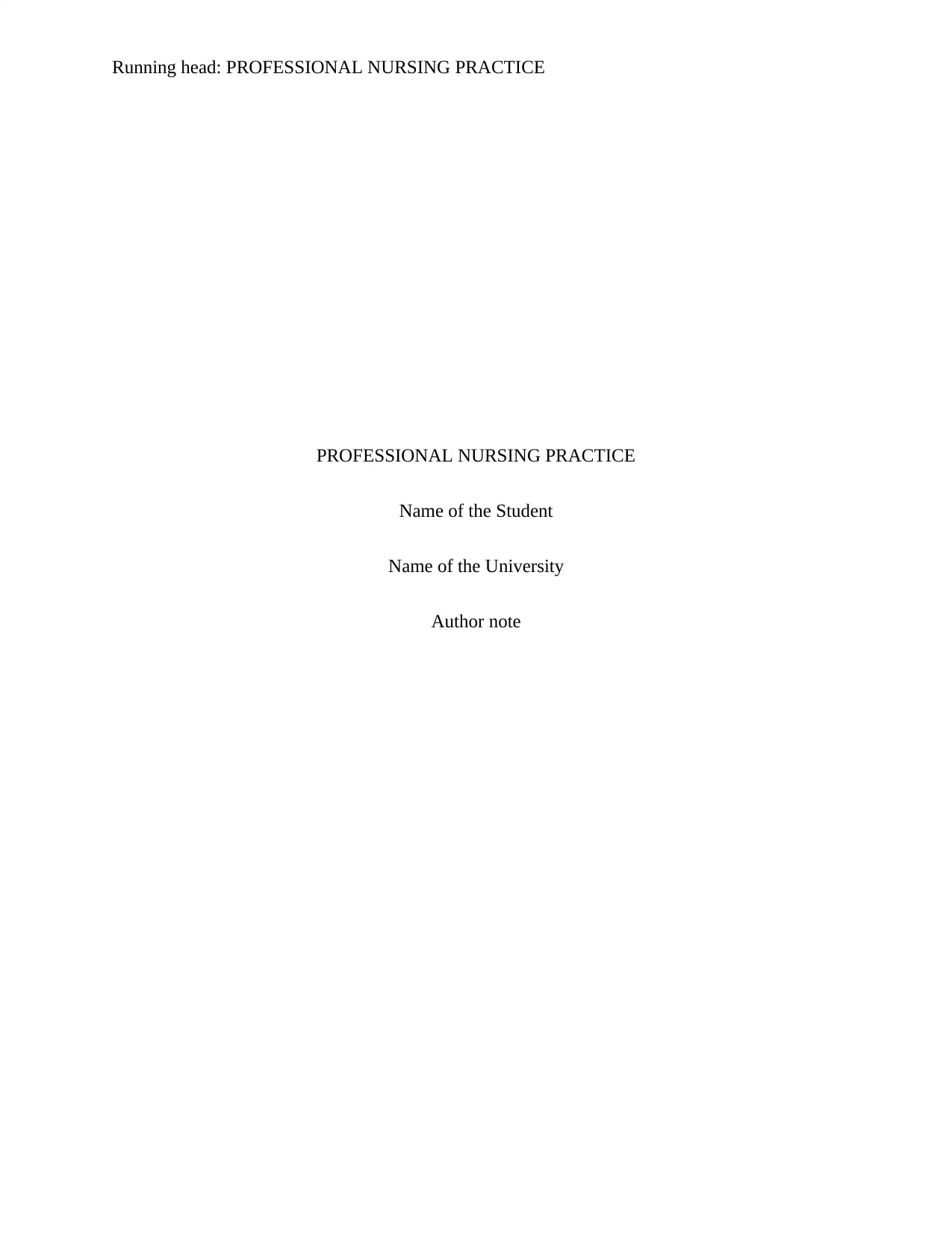
Running head: PROFESSIONAL NURSING PRACTICE
PROFESSIONAL NURSING PRACTICE
Name of the Student
Name of the University
Author note
PROFESSIONAL NURSING PRACTICE
Name of the Student
Name of the University
Author note
Paraphrase This Document
Need a fresh take? Get an instant paraphrase of this document with our AI Paraphraser
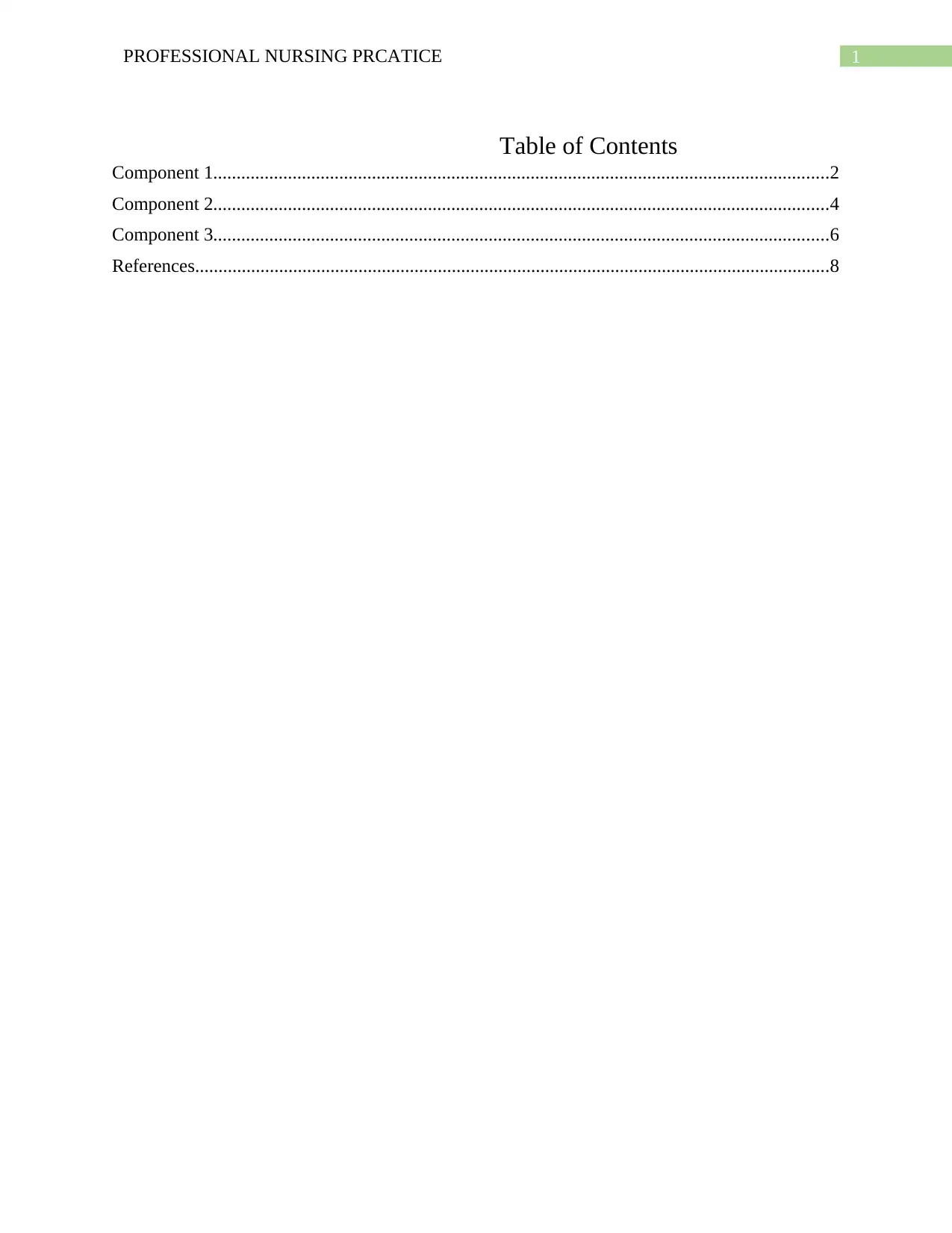
1PROFESSIONAL NURSING PRCATICE
Table of Contents
Component 1....................................................................................................................................2
Component 2....................................................................................................................................4
Component 3....................................................................................................................................6
References........................................................................................................................................8
Table of Contents
Component 1....................................................................................................................................2
Component 2....................................................................................................................................4
Component 3....................................................................................................................................6
References........................................................................................................................................8
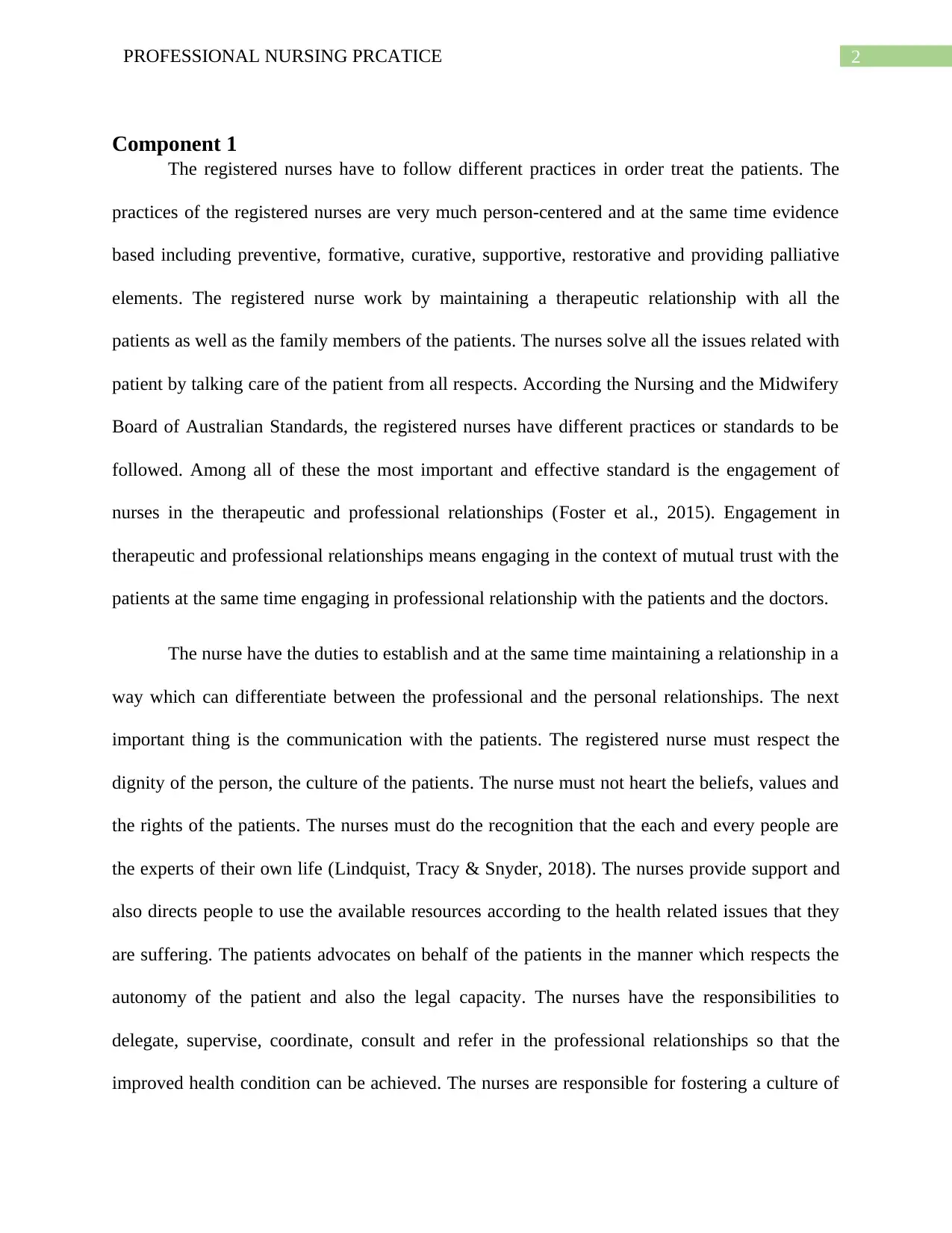
2PROFESSIONAL NURSING PRCATICE
Component 1
The registered nurses have to follow different practices in order treat the patients. The
practices of the registered nurses are very much person-centered and at the same time evidence
based including preventive, formative, curative, supportive, restorative and providing palliative
elements. The registered nurse work by maintaining a therapeutic relationship with all the
patients as well as the family members of the patients. The nurses solve all the issues related with
patient by talking care of the patient from all respects. According the Nursing and the Midwifery
Board of Australian Standards, the registered nurses have different practices or standards to be
followed. Among all of these the most important and effective standard is the engagement of
nurses in the therapeutic and professional relationships (Foster et al., 2015). Engagement in
therapeutic and professional relationships means engaging in the context of mutual trust with the
patients at the same time engaging in professional relationship with the patients and the doctors.
The nurse have the duties to establish and at the same time maintaining a relationship in a
way which can differentiate between the professional and the personal relationships. The next
important thing is the communication with the patients. The registered nurse must respect the
dignity of the person, the culture of the patients. The nurse must not heart the beliefs, values and
the rights of the patients. The nurses must do the recognition that the each and every people are
the experts of their own life (Lindquist, Tracy & Snyder, 2018). The nurses provide support and
also directs people to use the available resources according to the health related issues that they
are suffering. The patients advocates on behalf of the patients in the manner which respects the
autonomy of the patient and also the legal capacity. The nurses have the responsibilities to
delegate, supervise, coordinate, consult and refer in the professional relationships so that the
improved health condition can be achieved. The nurses are responsible for fostering a culture of
Component 1
The registered nurses have to follow different practices in order treat the patients. The
practices of the registered nurses are very much person-centered and at the same time evidence
based including preventive, formative, curative, supportive, restorative and providing palliative
elements. The registered nurse work by maintaining a therapeutic relationship with all the
patients as well as the family members of the patients. The nurses solve all the issues related with
patient by talking care of the patient from all respects. According the Nursing and the Midwifery
Board of Australian Standards, the registered nurses have different practices or standards to be
followed. Among all of these the most important and effective standard is the engagement of
nurses in the therapeutic and professional relationships (Foster et al., 2015). Engagement in
therapeutic and professional relationships means engaging in the context of mutual trust with the
patients at the same time engaging in professional relationship with the patients and the doctors.
The nurse have the duties to establish and at the same time maintaining a relationship in a
way which can differentiate between the professional and the personal relationships. The next
important thing is the communication with the patients. The registered nurse must respect the
dignity of the person, the culture of the patients. The nurse must not heart the beliefs, values and
the rights of the patients. The nurses must do the recognition that the each and every people are
the experts of their own life (Lindquist, Tracy & Snyder, 2018). The nurses provide support and
also directs people to use the available resources according to the health related issues that they
are suffering. The patients advocates on behalf of the patients in the manner which respects the
autonomy of the patient and also the legal capacity. The nurses have the responsibilities to
delegate, supervise, coordinate, consult and refer in the professional relationships so that the
improved health condition can be achieved. The nurses are responsible for fostering a culture of
⊘ This is a preview!⊘
Do you want full access?
Subscribe today to unlock all pages.

Trusted by 1+ million students worldwide
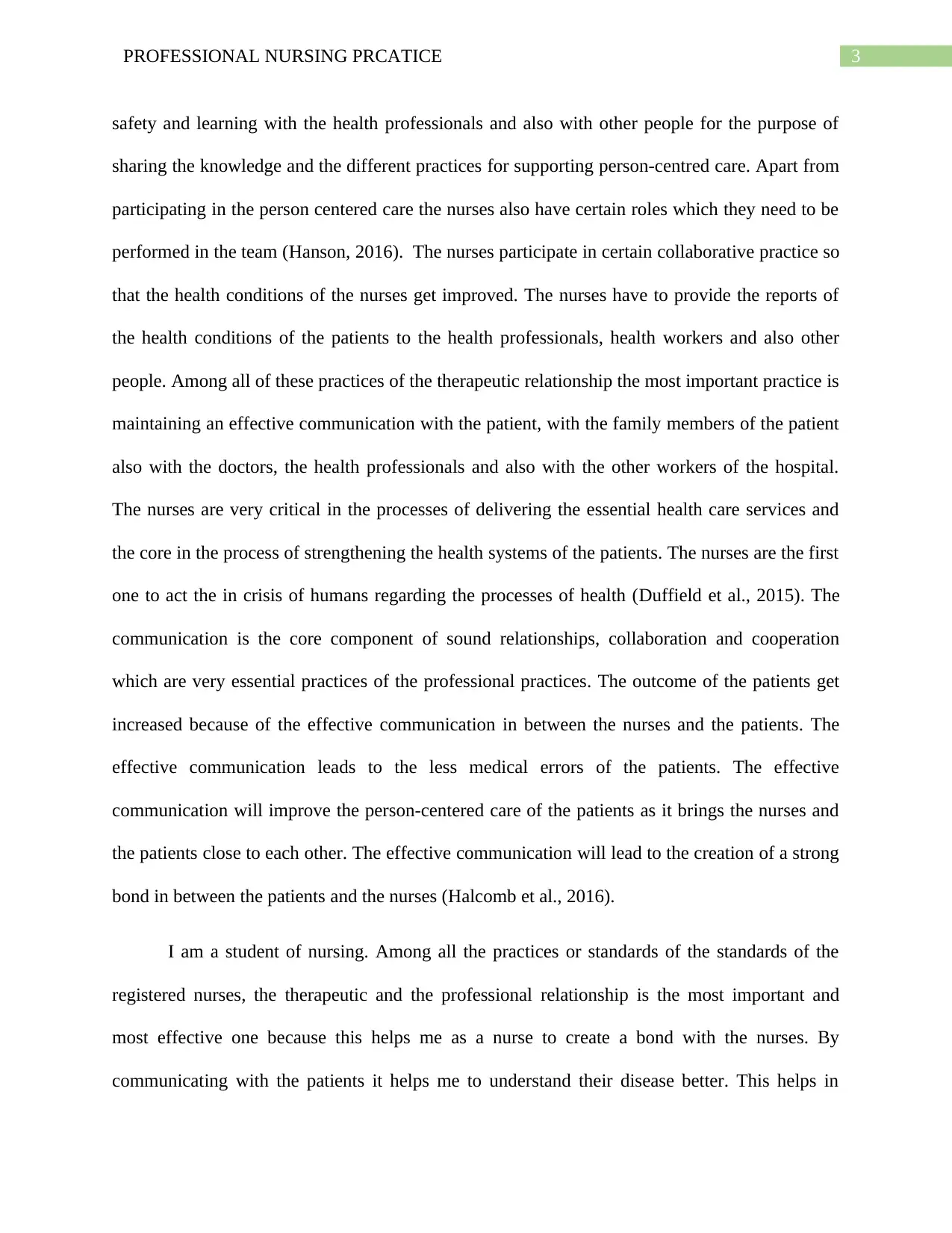
3PROFESSIONAL NURSING PRCATICE
safety and learning with the health professionals and also with other people for the purpose of
sharing the knowledge and the different practices for supporting person-centred care. Apart from
participating in the person centered care the nurses also have certain roles which they need to be
performed in the team (Hanson, 2016). The nurses participate in certain collaborative practice so
that the health conditions of the nurses get improved. The nurses have to provide the reports of
the health conditions of the patients to the health professionals, health workers and also other
people. Among all of these practices of the therapeutic relationship the most important practice is
maintaining an effective communication with the patient, with the family members of the patient
also with the doctors, the health professionals and also with the other workers of the hospital.
The nurses are very critical in the processes of delivering the essential health care services and
the core in the process of strengthening the health systems of the patients. The nurses are the first
one to act the in crisis of humans regarding the processes of health (Duffield et al., 2015). The
communication is the core component of sound relationships, collaboration and cooperation
which are very essential practices of the professional practices. The outcome of the patients get
increased because of the effective communication in between the nurses and the patients. The
effective communication leads to the less medical errors of the patients. The effective
communication will improve the person-centered care of the patients as it brings the nurses and
the patients close to each other. The effective communication will lead to the creation of a strong
bond in between the patients and the nurses (Halcomb et al., 2016).
I am a student of nursing. Among all the practices or standards of the standards of the
registered nurses, the therapeutic and the professional relationship is the most important and
most effective one because this helps me as a nurse to create a bond with the nurses. By
communicating with the patients it helps me to understand their disease better. This helps in
safety and learning with the health professionals and also with other people for the purpose of
sharing the knowledge and the different practices for supporting person-centred care. Apart from
participating in the person centered care the nurses also have certain roles which they need to be
performed in the team (Hanson, 2016). The nurses participate in certain collaborative practice so
that the health conditions of the nurses get improved. The nurses have to provide the reports of
the health conditions of the patients to the health professionals, health workers and also other
people. Among all of these practices of the therapeutic relationship the most important practice is
maintaining an effective communication with the patient, with the family members of the patient
also with the doctors, the health professionals and also with the other workers of the hospital.
The nurses are very critical in the processes of delivering the essential health care services and
the core in the process of strengthening the health systems of the patients. The nurses are the first
one to act the in crisis of humans regarding the processes of health (Duffield et al., 2015). The
communication is the core component of sound relationships, collaboration and cooperation
which are very essential practices of the professional practices. The outcome of the patients get
increased because of the effective communication in between the nurses and the patients. The
effective communication leads to the less medical errors of the patients. The effective
communication will improve the person-centered care of the patients as it brings the nurses and
the patients close to each other. The effective communication will lead to the creation of a strong
bond in between the patients and the nurses (Halcomb et al., 2016).
I am a student of nursing. Among all the practices or standards of the standards of the
registered nurses, the therapeutic and the professional relationship is the most important and
most effective one because this helps me as a nurse to create a bond with the nurses. By
communicating with the patients it helps me to understand their disease better. This helps in
Paraphrase This Document
Need a fresh take? Get an instant paraphrase of this document with our AI Paraphraser
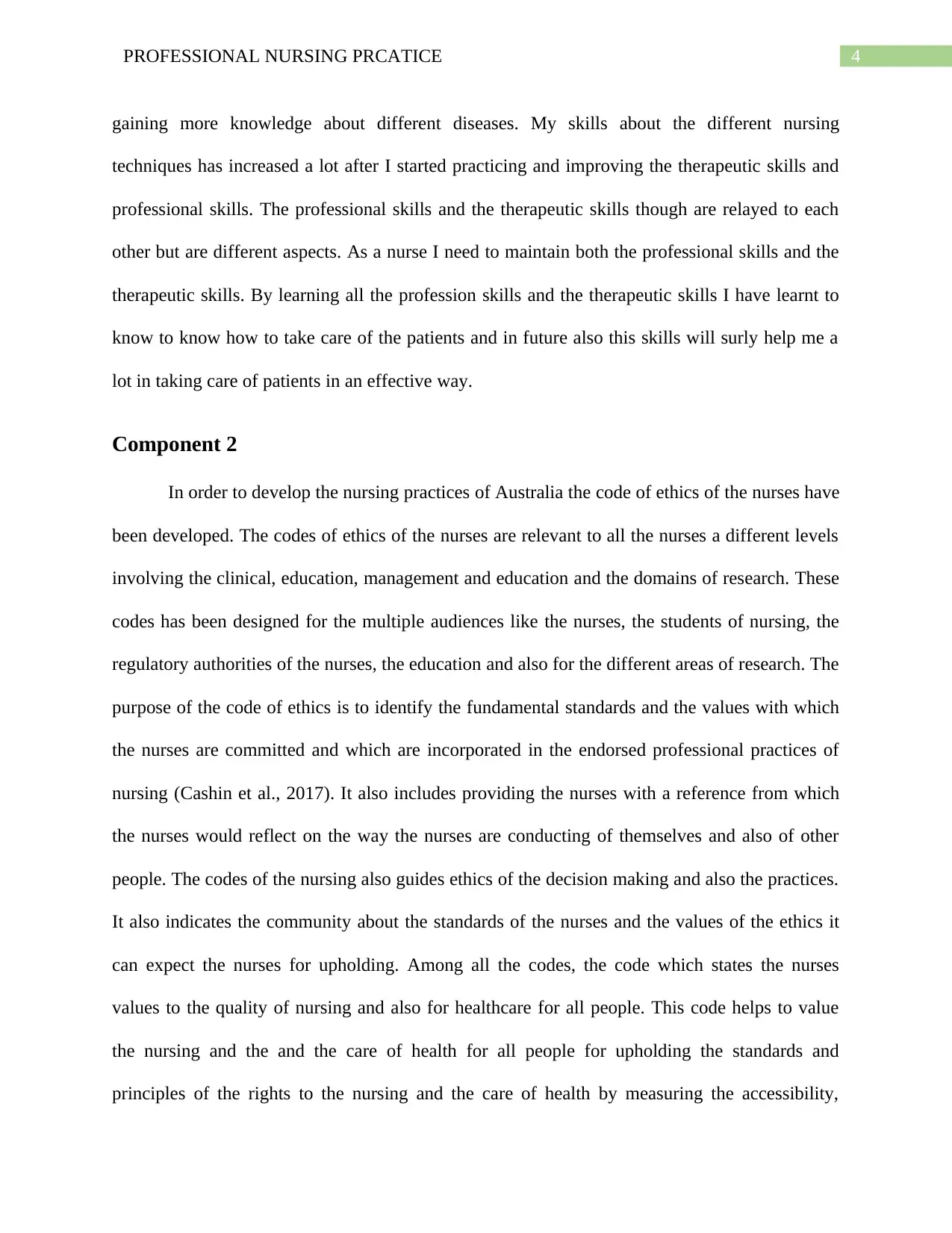
4PROFESSIONAL NURSING PRCATICE
gaining more knowledge about different diseases. My skills about the different nursing
techniques has increased a lot after I started practicing and improving the therapeutic skills and
professional skills. The professional skills and the therapeutic skills though are relayed to each
other but are different aspects. As a nurse I need to maintain both the professional skills and the
therapeutic skills. By learning all the profession skills and the therapeutic skills I have learnt to
know to know how to take care of the patients and in future also this skills will surly help me a
lot in taking care of patients in an effective way.
Component 2
In order to develop the nursing practices of Australia the code of ethics of the nurses have
been developed. The codes of ethics of the nurses are relevant to all the nurses a different levels
involving the clinical, education, management and education and the domains of research. These
codes has been designed for the multiple audiences like the nurses, the students of nursing, the
regulatory authorities of the nurses, the education and also for the different areas of research. The
purpose of the code of ethics is to identify the fundamental standards and the values with which
the nurses are committed and which are incorporated in the endorsed professional practices of
nursing (Cashin et al., 2017). It also includes providing the nurses with a reference from which
the nurses would reflect on the way the nurses are conducting of themselves and also of other
people. The codes of the nursing also guides ethics of the decision making and also the practices.
It also indicates the community about the standards of the nurses and the values of the ethics it
can expect the nurses for upholding. Among all the codes, the code which states the nurses
values to the quality of nursing and also for healthcare for all people. This code helps to value
the nursing and the and the care of health for all people for upholding the standards and
principles of the rights to the nursing and the care of health by measuring the accessibility,
gaining more knowledge about different diseases. My skills about the different nursing
techniques has increased a lot after I started practicing and improving the therapeutic skills and
professional skills. The professional skills and the therapeutic skills though are relayed to each
other but are different aspects. As a nurse I need to maintain both the professional skills and the
therapeutic skills. By learning all the profession skills and the therapeutic skills I have learnt to
know to know how to take care of the patients and in future also this skills will surly help me a
lot in taking care of patients in an effective way.
Component 2
In order to develop the nursing practices of Australia the code of ethics of the nurses have
been developed. The codes of ethics of the nurses are relevant to all the nurses a different levels
involving the clinical, education, management and education and the domains of research. These
codes has been designed for the multiple audiences like the nurses, the students of nursing, the
regulatory authorities of the nurses, the education and also for the different areas of research. The
purpose of the code of ethics is to identify the fundamental standards and the values with which
the nurses are committed and which are incorporated in the endorsed professional practices of
nursing (Cashin et al., 2017). It also includes providing the nurses with a reference from which
the nurses would reflect on the way the nurses are conducting of themselves and also of other
people. The codes of the nursing also guides ethics of the decision making and also the practices.
It also indicates the community about the standards of the nurses and the values of the ethics it
can expect the nurses for upholding. Among all the codes, the code which states the nurses
values to the quality of nursing and also for healthcare for all people. This code helps to value
the nursing and the and the care of health for all people for upholding the standards and
principles of the rights to the nursing and the care of health by measuring the accessibility,
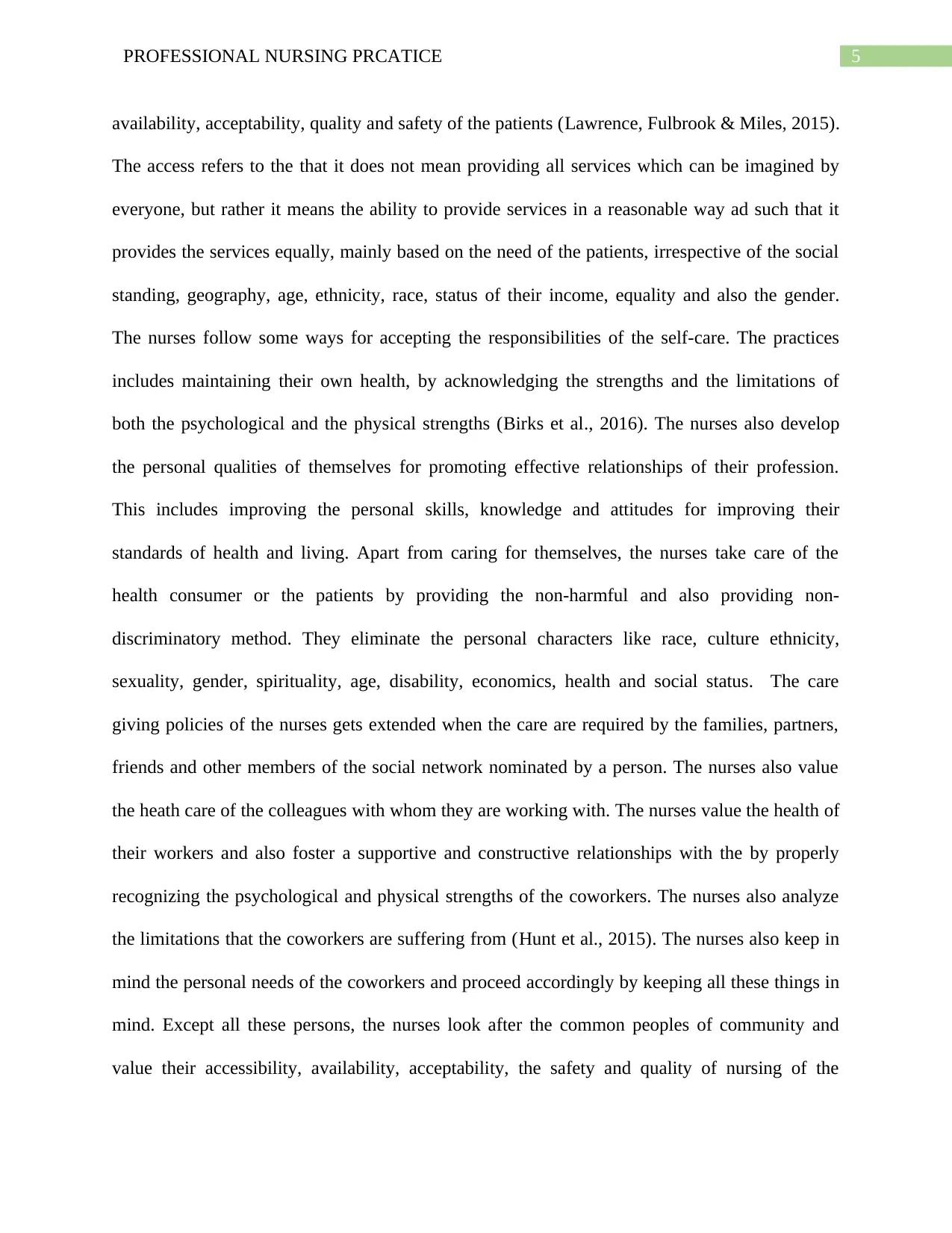
5PROFESSIONAL NURSING PRCATICE
availability, acceptability, quality and safety of the patients (Lawrence, Fulbrook & Miles, 2015).
The access refers to the that it does not mean providing all services which can be imagined by
everyone, but rather it means the ability to provide services in a reasonable way ad such that it
provides the services equally, mainly based on the need of the patients, irrespective of the social
standing, geography, age, ethnicity, race, status of their income, equality and also the gender.
The nurses follow some ways for accepting the responsibilities of the self-care. The practices
includes maintaining their own health, by acknowledging the strengths and the limitations of
both the psychological and the physical strengths (Birks et al., 2016). The nurses also develop
the personal qualities of themselves for promoting effective relationships of their profession.
This includes improving the personal skills, knowledge and attitudes for improving their
standards of health and living. Apart from caring for themselves, the nurses take care of the
health consumer or the patients by providing the non-harmful and also providing non-
discriminatory method. They eliminate the personal characters like race, culture ethnicity,
sexuality, gender, spirituality, age, disability, economics, health and social status. The care
giving policies of the nurses gets extended when the care are required by the families, partners,
friends and other members of the social network nominated by a person. The nurses also value
the heath care of the colleagues with whom they are working with. The nurses value the health of
their workers and also foster a supportive and constructive relationships with the by properly
recognizing the psychological and physical strengths of the coworkers. The nurses also analyze
the limitations that the coworkers are suffering from (Hunt et al., 2015). The nurses also keep in
mind the personal needs of the coworkers and proceed accordingly by keeping all these things in
mind. Except all these persons, the nurses look after the common peoples of community and
value their accessibility, availability, acceptability, the safety and quality of nursing of the
availability, acceptability, quality and safety of the patients (Lawrence, Fulbrook & Miles, 2015).
The access refers to the that it does not mean providing all services which can be imagined by
everyone, but rather it means the ability to provide services in a reasonable way ad such that it
provides the services equally, mainly based on the need of the patients, irrespective of the social
standing, geography, age, ethnicity, race, status of their income, equality and also the gender.
The nurses follow some ways for accepting the responsibilities of the self-care. The practices
includes maintaining their own health, by acknowledging the strengths and the limitations of
both the psychological and the physical strengths (Birks et al., 2016). The nurses also develop
the personal qualities of themselves for promoting effective relationships of their profession.
This includes improving the personal skills, knowledge and attitudes for improving their
standards of health and living. Apart from caring for themselves, the nurses take care of the
health consumer or the patients by providing the non-harmful and also providing non-
discriminatory method. They eliminate the personal characters like race, culture ethnicity,
sexuality, gender, spirituality, age, disability, economics, health and social status. The care
giving policies of the nurses gets extended when the care are required by the families, partners,
friends and other members of the social network nominated by a person. The nurses also value
the heath care of the colleagues with whom they are working with. The nurses value the health of
their workers and also foster a supportive and constructive relationships with the by properly
recognizing the psychological and physical strengths of the coworkers. The nurses also analyze
the limitations that the coworkers are suffering from (Hunt et al., 2015). The nurses also keep in
mind the personal needs of the coworkers and proceed accordingly by keeping all these things in
mind. Except all these persons, the nurses look after the common peoples of community and
value their accessibility, availability, acceptability, the safety and quality of nursing of the
⊘ This is a preview!⊘
Do you want full access?
Subscribe today to unlock all pages.

Trusted by 1+ million students worldwide
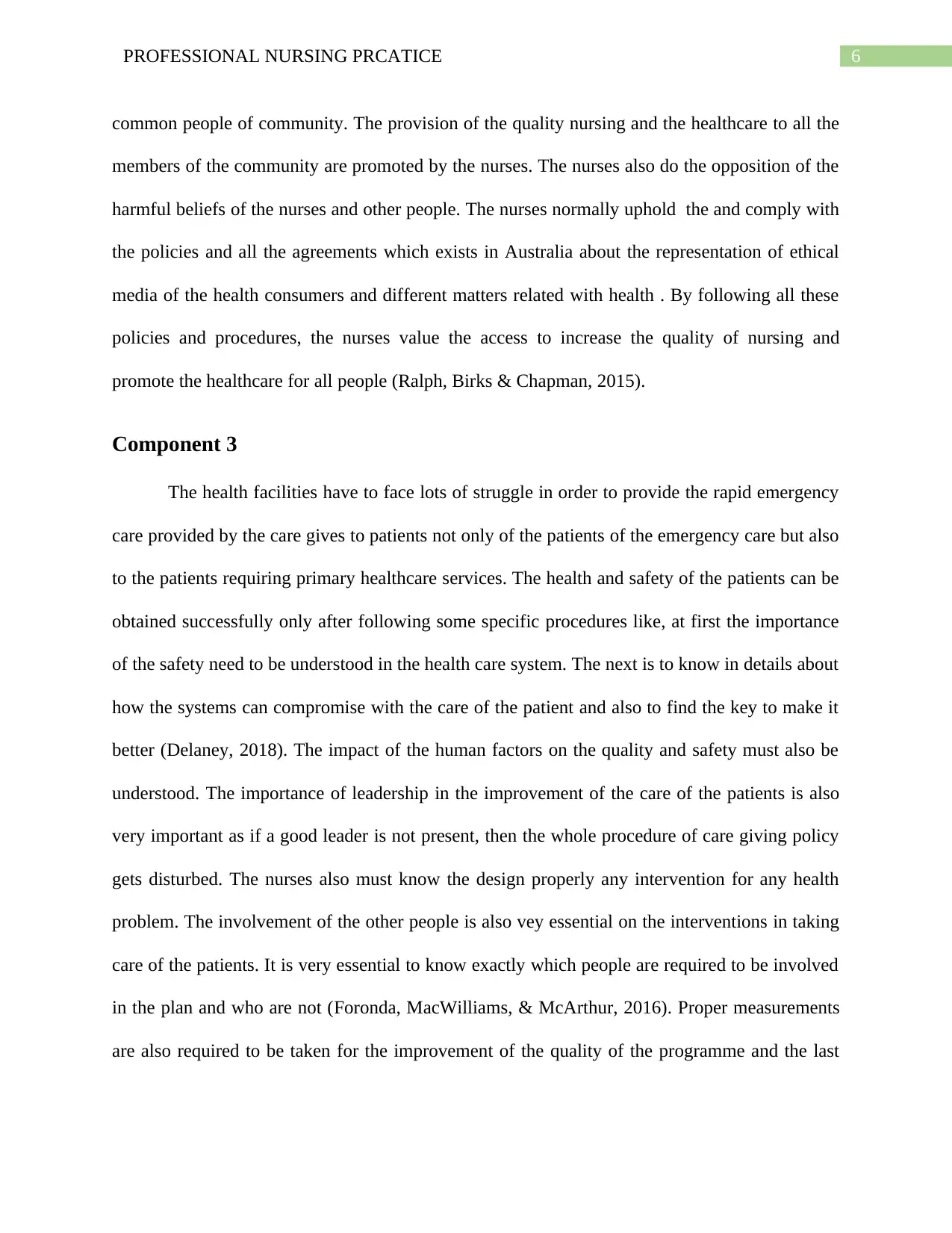
6PROFESSIONAL NURSING PRCATICE
common people of community. The provision of the quality nursing and the healthcare to all the
members of the community are promoted by the nurses. The nurses also do the opposition of the
harmful beliefs of the nurses and other people. The nurses normally uphold the and comply with
the policies and all the agreements which exists in Australia about the representation of ethical
media of the health consumers and different matters related with health . By following all these
policies and procedures, the nurses value the access to increase the quality of nursing and
promote the healthcare for all people (Ralph, Birks & Chapman, 2015).
Component 3
The health facilities have to face lots of struggle in order to provide the rapid emergency
care provided by the care gives to patients not only of the patients of the emergency care but also
to the patients requiring primary healthcare services. The health and safety of the patients can be
obtained successfully only after following some specific procedures like, at first the importance
of the safety need to be understood in the health care system. The next is to know in details about
how the systems can compromise with the care of the patient and also to find the key to make it
better (Delaney, 2018). The impact of the human factors on the quality and safety must also be
understood. The importance of leadership in the improvement of the care of the patients is also
very important as if a good leader is not present, then the whole procedure of care giving policy
gets disturbed. The nurses also must know the design properly any intervention for any health
problem. The involvement of the other people is also vey essential on the interventions in taking
care of the patients. It is very essential to know exactly which people are required to be involved
in the plan and who are not (Foronda, MacWilliams, & McArthur, 2016). Proper measurements
are also required to be taken for the improvement of the quality of the programme and the last
common people of community. The provision of the quality nursing and the healthcare to all the
members of the community are promoted by the nurses. The nurses also do the opposition of the
harmful beliefs of the nurses and other people. The nurses normally uphold the and comply with
the policies and all the agreements which exists in Australia about the representation of ethical
media of the health consumers and different matters related with health . By following all these
policies and procedures, the nurses value the access to increase the quality of nursing and
promote the healthcare for all people (Ralph, Birks & Chapman, 2015).
Component 3
The health facilities have to face lots of struggle in order to provide the rapid emergency
care provided by the care gives to patients not only of the patients of the emergency care but also
to the patients requiring primary healthcare services. The health and safety of the patients can be
obtained successfully only after following some specific procedures like, at first the importance
of the safety need to be understood in the health care system. The next is to know in details about
how the systems can compromise with the care of the patient and also to find the key to make it
better (Delaney, 2018). The impact of the human factors on the quality and safety must also be
understood. The importance of leadership in the improvement of the care of the patients is also
very important as if a good leader is not present, then the whole procedure of care giving policy
gets disturbed. The nurses also must know the design properly any intervention for any health
problem. The involvement of the other people is also vey essential on the interventions in taking
care of the patients. It is very essential to know exactly which people are required to be involved
in the plan and who are not (Foronda, MacWilliams, & McArthur, 2016). Proper measurements
are also required to be taken for the improvement of the quality of the programme and the last
Paraphrase This Document
Need a fresh take? Get an instant paraphrase of this document with our AI Paraphraser
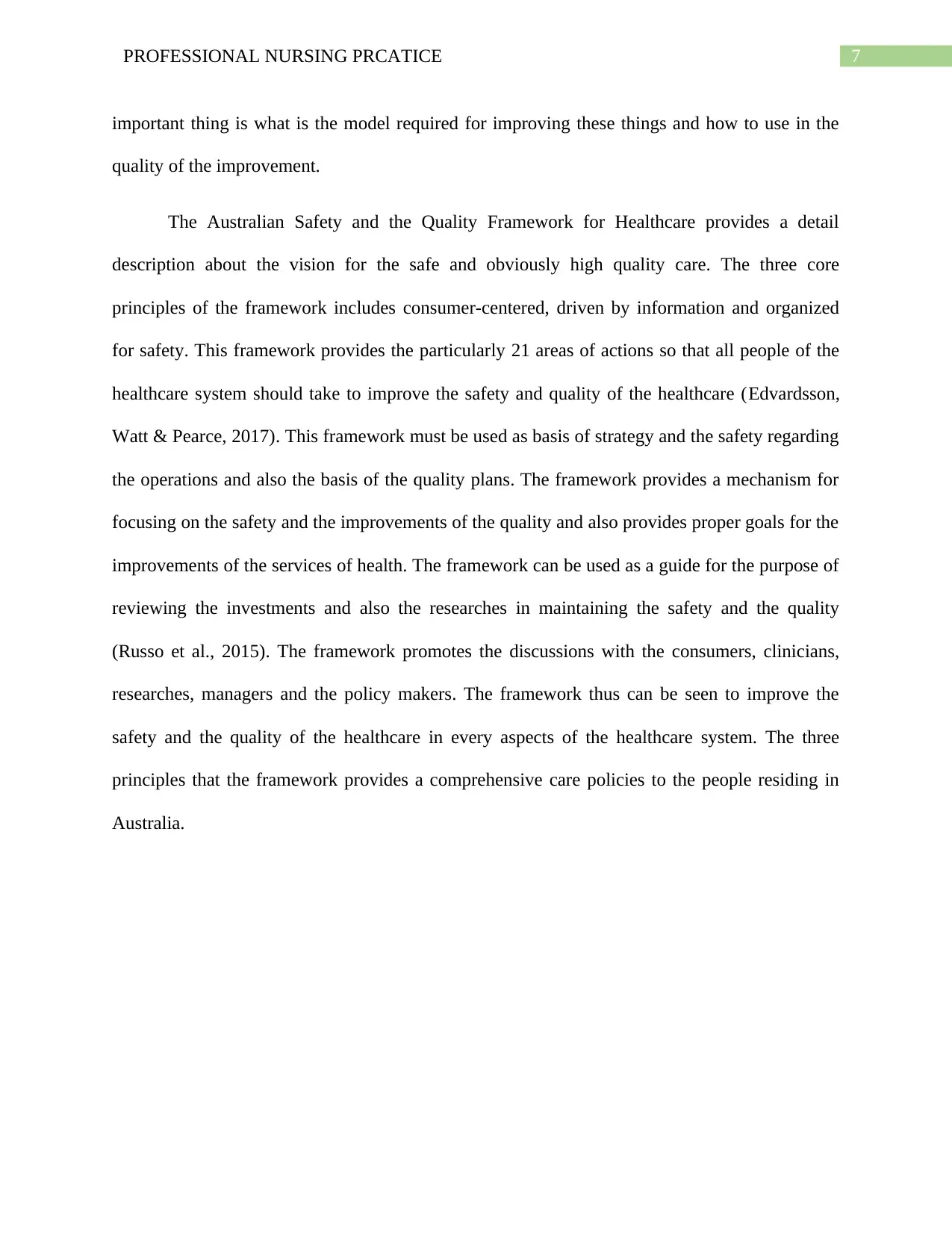
7PROFESSIONAL NURSING PRCATICE
important thing is what is the model required for improving these things and how to use in the
quality of the improvement.
The Australian Safety and the Quality Framework for Healthcare provides a detail
description about the vision for the safe and obviously high quality care. The three core
principles of the framework includes consumer-centered, driven by information and organized
for safety. This framework provides the particularly 21 areas of actions so that all people of the
healthcare system should take to improve the safety and quality of the healthcare (Edvardsson,
Watt & Pearce, 2017). This framework must be used as basis of strategy and the safety regarding
the operations and also the basis of the quality plans. The framework provides a mechanism for
focusing on the safety and the improvements of the quality and also provides proper goals for the
improvements of the services of health. The framework can be used as a guide for the purpose of
reviewing the investments and also the researches in maintaining the safety and the quality
(Russo et al., 2015). The framework promotes the discussions with the consumers, clinicians,
researches, managers and the policy makers. The framework thus can be seen to improve the
safety and the quality of the healthcare in every aspects of the healthcare system. The three
principles that the framework provides a comprehensive care policies to the people residing in
Australia.
important thing is what is the model required for improving these things and how to use in the
quality of the improvement.
The Australian Safety and the Quality Framework for Healthcare provides a detail
description about the vision for the safe and obviously high quality care. The three core
principles of the framework includes consumer-centered, driven by information and organized
for safety. This framework provides the particularly 21 areas of actions so that all people of the
healthcare system should take to improve the safety and quality of the healthcare (Edvardsson,
Watt & Pearce, 2017). This framework must be used as basis of strategy and the safety regarding
the operations and also the basis of the quality plans. The framework provides a mechanism for
focusing on the safety and the improvements of the quality and also provides proper goals for the
improvements of the services of health. The framework can be used as a guide for the purpose of
reviewing the investments and also the researches in maintaining the safety and the quality
(Russo et al., 2015). The framework promotes the discussions with the consumers, clinicians,
researches, managers and the policy makers. The framework thus can be seen to improve the
safety and the quality of the healthcare in every aspects of the healthcare system. The three
principles that the framework provides a comprehensive care policies to the people residing in
Australia.
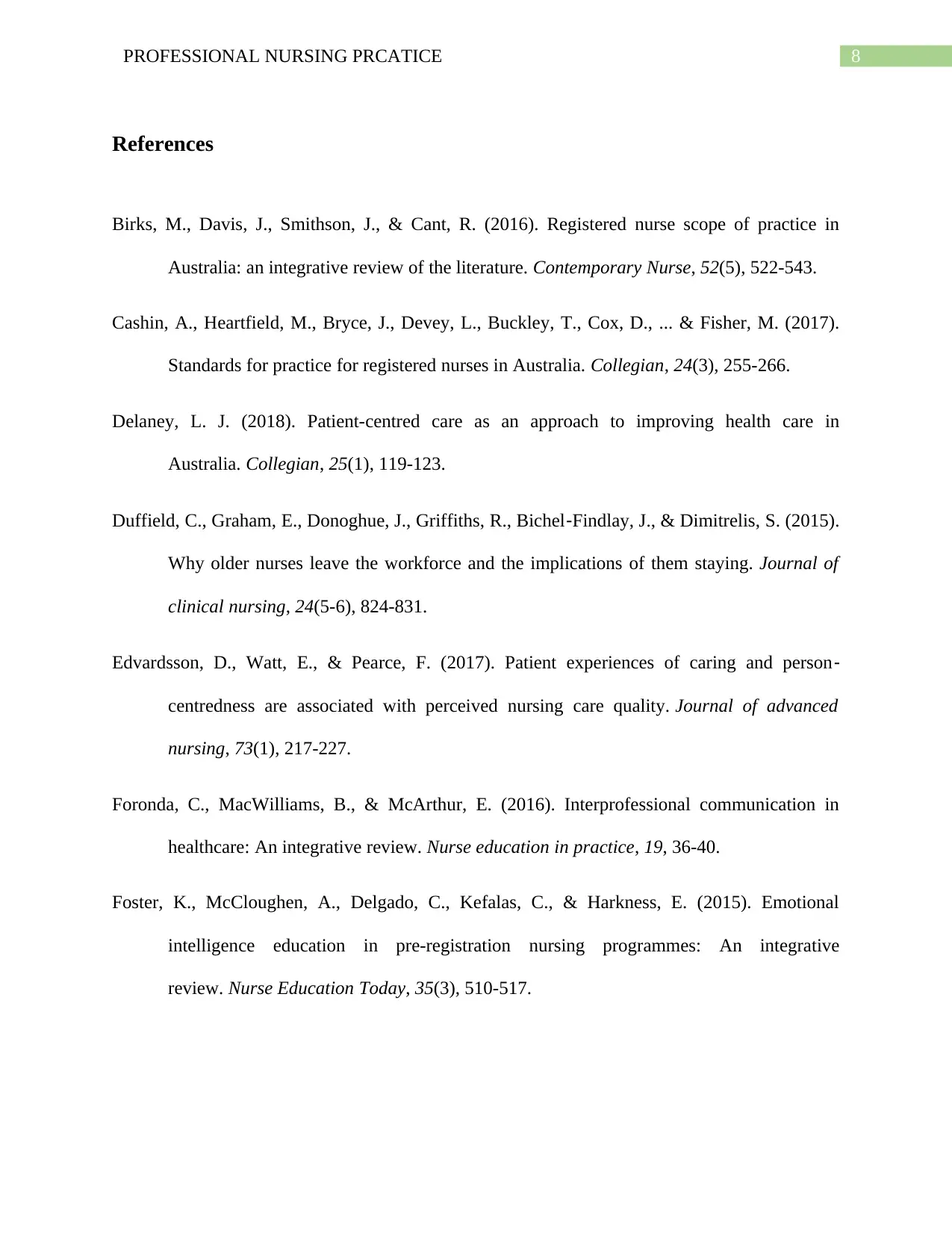
8PROFESSIONAL NURSING PRCATICE
References
Birks, M., Davis, J., Smithson, J., & Cant, R. (2016). Registered nurse scope of practice in
Australia: an integrative review of the literature. Contemporary Nurse, 52(5), 522-543.
Cashin, A., Heartfield, M., Bryce, J., Devey, L., Buckley, T., Cox, D., ... & Fisher, M. (2017).
Standards for practice for registered nurses in Australia. Collegian, 24(3), 255-266.
Delaney, L. J. (2018). Patient-centred care as an approach to improving health care in
Australia. Collegian, 25(1), 119-123.
Duffield, C., Graham, E., Donoghue, J., Griffiths, R., Bichel‐Findlay, J., & Dimitrelis, S. (2015).
Why older nurses leave the workforce and the implications of them staying. Journal of
clinical nursing, 24(5-6), 824-831.
Edvardsson, D., Watt, E., & Pearce, F. (2017). Patient experiences of caring and person‐
centredness are associated with perceived nursing care quality. Journal of advanced
nursing, 73(1), 217-227.
Foronda, C., MacWilliams, B., & McArthur, E. (2016). Interprofessional communication in
healthcare: An integrative review. Nurse education in practice, 19, 36-40.
Foster, K., McCloughen, A., Delgado, C., Kefalas, C., & Harkness, E. (2015). Emotional
intelligence education in pre-registration nursing programmes: An integrative
review. Nurse Education Today, 35(3), 510-517.
References
Birks, M., Davis, J., Smithson, J., & Cant, R. (2016). Registered nurse scope of practice in
Australia: an integrative review of the literature. Contemporary Nurse, 52(5), 522-543.
Cashin, A., Heartfield, M., Bryce, J., Devey, L., Buckley, T., Cox, D., ... & Fisher, M. (2017).
Standards for practice for registered nurses in Australia. Collegian, 24(3), 255-266.
Delaney, L. J. (2018). Patient-centred care as an approach to improving health care in
Australia. Collegian, 25(1), 119-123.
Duffield, C., Graham, E., Donoghue, J., Griffiths, R., Bichel‐Findlay, J., & Dimitrelis, S. (2015).
Why older nurses leave the workforce and the implications of them staying. Journal of
clinical nursing, 24(5-6), 824-831.
Edvardsson, D., Watt, E., & Pearce, F. (2017). Patient experiences of caring and person‐
centredness are associated with perceived nursing care quality. Journal of advanced
nursing, 73(1), 217-227.
Foronda, C., MacWilliams, B., & McArthur, E. (2016). Interprofessional communication in
healthcare: An integrative review. Nurse education in practice, 19, 36-40.
Foster, K., McCloughen, A., Delgado, C., Kefalas, C., & Harkness, E. (2015). Emotional
intelligence education in pre-registration nursing programmes: An integrative
review. Nurse Education Today, 35(3), 510-517.
⊘ This is a preview!⊘
Do you want full access?
Subscribe today to unlock all pages.

Trusted by 1+ million students worldwide
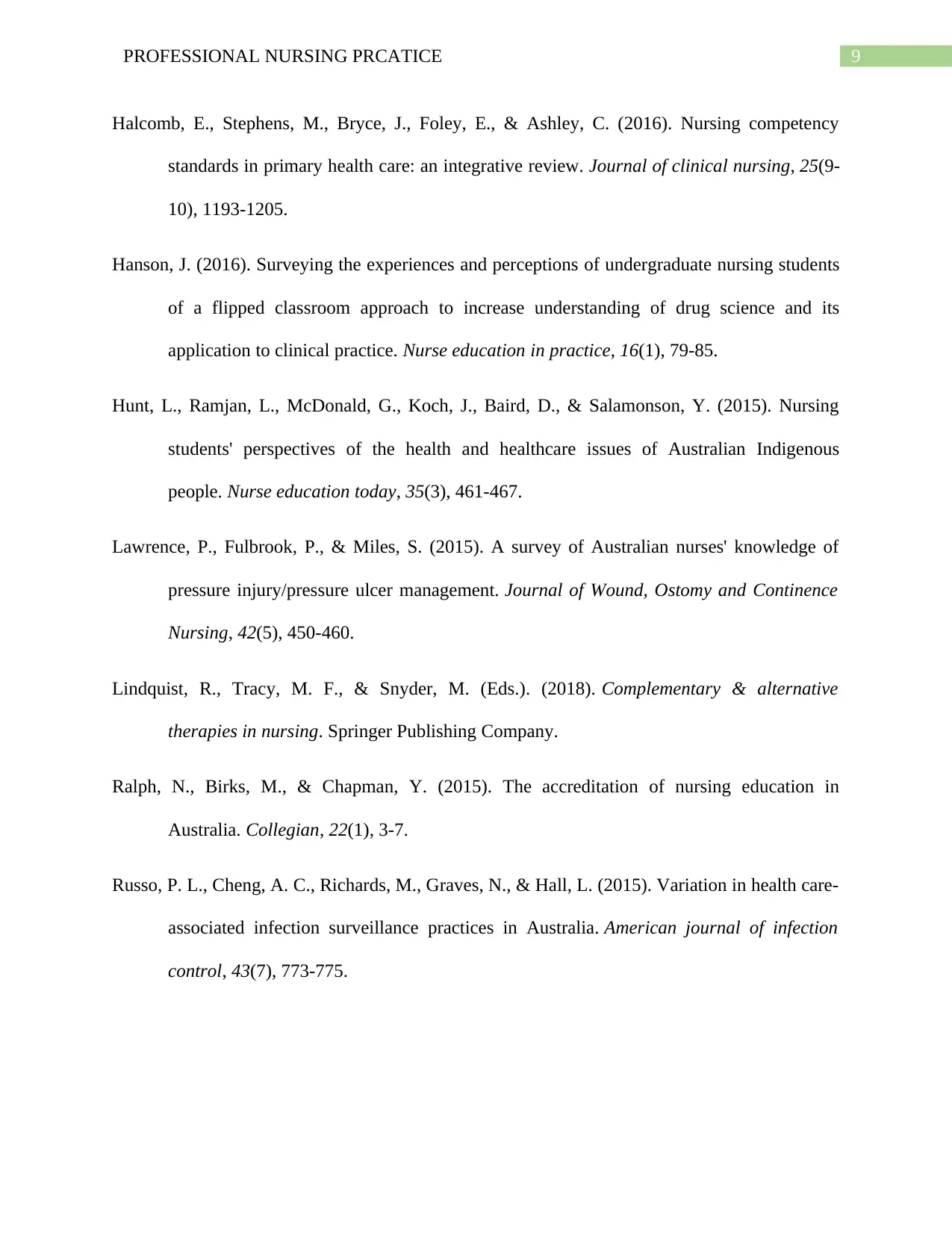
9PROFESSIONAL NURSING PRCATICE
Halcomb, E., Stephens, M., Bryce, J., Foley, E., & Ashley, C. (2016). Nursing competency
standards in primary health care: an integrative review. Journal of clinical nursing, 25(9-
10), 1193-1205.
Hanson, J. (2016). Surveying the experiences and perceptions of undergraduate nursing students
of a flipped classroom approach to increase understanding of drug science and its
application to clinical practice. Nurse education in practice, 16(1), 79-85.
Hunt, L., Ramjan, L., McDonald, G., Koch, J., Baird, D., & Salamonson, Y. (2015). Nursing
students' perspectives of the health and healthcare issues of Australian Indigenous
people. Nurse education today, 35(3), 461-467.
Lawrence, P., Fulbrook, P., & Miles, S. (2015). A survey of Australian nurses' knowledge of
pressure injury/pressure ulcer management. Journal of Wound, Ostomy and Continence
Nursing, 42(5), 450-460.
Lindquist, R., Tracy, M. F., & Snyder, M. (Eds.). (2018). Complementary & alternative
therapies in nursing. Springer Publishing Company.
Ralph, N., Birks, M., & Chapman, Y. (2015). The accreditation of nursing education in
Australia. Collegian, 22(1), 3-7.
Russo, P. L., Cheng, A. C., Richards, M., Graves, N., & Hall, L. (2015). Variation in health care-
associated infection surveillance practices in Australia. American journal of infection
control, 43(7), 773-775.
Halcomb, E., Stephens, M., Bryce, J., Foley, E., & Ashley, C. (2016). Nursing competency
standards in primary health care: an integrative review. Journal of clinical nursing, 25(9-
10), 1193-1205.
Hanson, J. (2016). Surveying the experiences and perceptions of undergraduate nursing students
of a flipped classroom approach to increase understanding of drug science and its
application to clinical practice. Nurse education in practice, 16(1), 79-85.
Hunt, L., Ramjan, L., McDonald, G., Koch, J., Baird, D., & Salamonson, Y. (2015). Nursing
students' perspectives of the health and healthcare issues of Australian Indigenous
people. Nurse education today, 35(3), 461-467.
Lawrence, P., Fulbrook, P., & Miles, S. (2015). A survey of Australian nurses' knowledge of
pressure injury/pressure ulcer management. Journal of Wound, Ostomy and Continence
Nursing, 42(5), 450-460.
Lindquist, R., Tracy, M. F., & Snyder, M. (Eds.). (2018). Complementary & alternative
therapies in nursing. Springer Publishing Company.
Ralph, N., Birks, M., & Chapman, Y. (2015). The accreditation of nursing education in
Australia. Collegian, 22(1), 3-7.
Russo, P. L., Cheng, A. C., Richards, M., Graves, N., & Hall, L. (2015). Variation in health care-
associated infection surveillance practices in Australia. American journal of infection
control, 43(7), 773-775.
1 out of 10
Related Documents
Your All-in-One AI-Powered Toolkit for Academic Success.
+13062052269
info@desklib.com
Available 24*7 on WhatsApp / Email
![[object Object]](/_next/static/media/star-bottom.7253800d.svg)
Unlock your academic potential
Copyright © 2020–2025 A2Z Services. All Rights Reserved. Developed and managed by ZUCOL.




